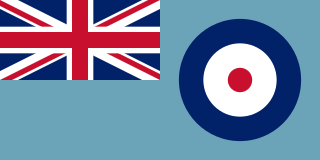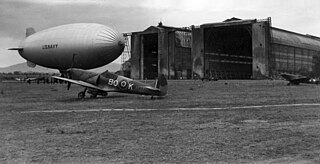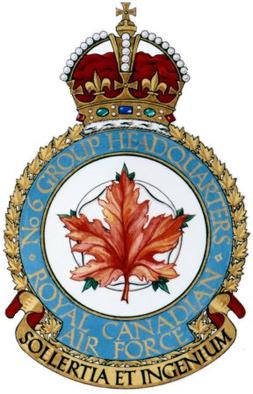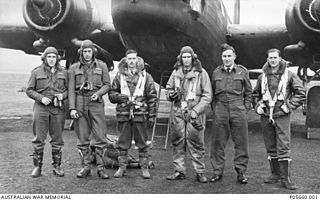
Number 99 Squadron is a squadron of the Royal Air Force which operates the Boeing C-17 Globemaster III strategic/tactical transport aircraft from RAF Brize Norton.

Royal Air Force Aldermaston, or more simply RAF Aldermaston, is a former Royal Air Force station located 8 miles (13 km) east of Newbury, Berkshire and 9.8 miles (15.8 km) southwest of Reading, Berkshire, England.

No. 5 Group RAF was a Royal Air Force bomber group of the Second World War, led during the latter part by AVM Sir Ralph Cochrane.
No. 75 Squadron was a unit of the Royal Flying Corps and Royal Air Force in World War I and the RAF in World War II. In 1940–1945, it was a bomber unit comprised mainly of New Zealand-born personnel. In October 1945, the squadron number – along with its heraldry and honours – was relinquished by the RAF and transferred to the Royal New Zealand Air Force, officially becoming No. 75 Squadron RNZAF. No other RAF squadron has been gifted in this way, to another Commonwealth air force.

No. 311 (Czechoslovak) Squadron RAF was a Czechoslovak-manned bomber squadron of the Royal Air Force in the Second World War. It was the RAF's only Czechoslovak-manned medium and heavy bomber squadron. It suffered the heaviest losses of any Czechoslovak formation in the RAF. In the Second World War 511 Czechoslovaks serving in Allied air forces were killed. Of these 273 (53%) died while serving with 311 Squadron.
No. 630 Squadron RAF was a heavy bomber squadron of the Royal Air Force during the Second World War.

No. 451 Squadron was a Royal Australian Air Force army cooperation and fighter squadron of World War II. It was formed at Bankstown, New South Wales, on 12 February 1941 and began flying operations on 1 July as part of the North African Campaign in Egypt and Libya. No. 451 Squadron was withdrawn for refitting in early January 1942 and spent the remainder of the year performing garrison duties in Syria. In January 1943, it was transferred to Egypt to contribute to local air defence but saw almost no combat. This inactivity caused morale among the squadron's personnel to greatly deteriorate.

No. 6 Group RCAF was a group of Royal Canadian Air Force (RCAF) heavy bomber squadrons in Europe during the Second World War, between 1942 and 1945. The group operated out of airfields in Yorkshire, England.

No. 40 Squadron of the Royal Air Force was formed in 1916 at Gosport as No. 40 Squadron Royal Flying Corps and was disbanded for the last time in 1957. The squadron also included many non-British members, including volunteers from the Royal Australian Air Force and Royal Canadian Air Force.

Royal Air Force Horsham St Faith or more simply RAF Horsham St Faith is a former Royal Air Force station near Norwich, Norfolk, England which was operational from 1939 to 1963. It was then developed as Norwich International Airport.

Royal Air Force Andrews Field or more simply RAF Andrews Field is a former Royal Air Force station located 4 miles (6.4 km) east-northeast of Great Dunmow Essex, England.

No. 458 Squadron RAAF was a Royal Australian Air Force squadron that operated during World War II. It was formed in Australia under Article XV of the Empire Air Training Scheme. The squadron flew various versions of Vickers Wellington bombers, first in Europe and later in the Middle East. It was disbanded in mid-1945, following the conclusion of hostilities in Europe.

No. 463 Squadron RAAF was a Royal Australian Air Force heavy bomber squadron during World War II. The squadron was formed in the United Kingdom in late 1943 from personnel and aircraft allocated from No. 467 Squadron RAAF. The squadron was equipped with Avro Lancaster bombers and flew its first raids on Germany immediately after being formed. Operating as part of RAF Bomber Command No. 463 Squadron conducted raids against cities, industrial facilities and military targets in Germany, France and Norway throughout 1944 and until the end of the war in May 1945. Following the war, the squadron evacuated Allied prisoners of war from Europe until it was disbanded in late 1945.

No. 464 Squadron RAAF is a Royal Australian Air Force (RAAF) unit responsible for public relations. It was originally formed in the United Kingdom during 1942 as a bomber unit. It comprised personnel from Australia, Britain, Canada, New Zealand, South Africa and the Netherlands, the squadron served in the light bomber role, undertaking operations over France and the Low Countries, from bases in England. It also flew night fighter missions. Later, following the Allied invasion of France, the squadron moved to France where it was used to interdict German transports and infrastructure. It further engaged in several low-level precision raids against Gestapo targets in France and Denmark. The squadron was disbanded in September 1945, following the conclusion of the war. No. 464 Squadron was re-formed in January 2021 when the RAAF's public relations functions were transferred from No. 28 Squadron.
No. 215 Squadron RAF was a Royal Air Force aircraft squadron formed as a night bomber squadron in the First and Second World Wars, becoming a transport squadron near the end of the Second World War.
No. 158 Squadron RAF was a World War I proposed ground attack squadron that did not become operational in time to see action, and a World War II bomber squadron. After World War II had ended in Europe the squadron operated in the transport role until disbandment in December 1945.

No. 4 Group RAF (4Gp) was a Royal Air Force group, originally formed in the First World War, and reformed in the wake of the Second World War, mostly part of RAF Bomber Command, but ending its days in RAF Transport Command.

No. 226 Squadron RAF was a unit of the British Royal Air Force that existed as a bomber squadron during the First and Second World Wars, and as part of the UK's nuclear ballistic missile force in the early 1960s.
No. 114 Squadron was a squadron of the British Royal Air Force. It was first formed in India during the First World War, serving as a light bomber squadron during the Second World War and as a transport squadron post-war. It was last disbanded in 1971.
The No. 347 Squadron RAF was a French bomber squadron given a Royal Air Force squadron number during World War II.












